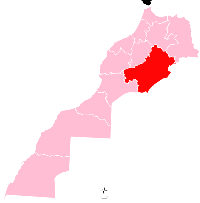Skoura
Skoura
ⵙⴽⵓⵔⴰ سكورة | |
|---|---|
Town | |
UTC+1 (WEST ) |
Skoura (
. It consists of a modern town as well as a historical oasis and palmeraie with traditional rammed-earth architecture.Geography

Skoura consists of a historic fertile oasis lined with immense palm groves (a "palmeraie"), existing at the confluence of several rivers and streams descending from the central High Atlas mountains. Within the oasis, a few of these rivers join together to form the river known as Oued el-Hajjaj, which in turn joins the Oued Dadès (Dadès River) a short distance further south. The main modern town of Skoura today exists on the eastern edge of the oasis, along the main road from Ouarzazate.[1][2]
Skoura is also the name of a Geological Basin.[3]
Agriculture

Many of these rivers remain dry outside the spring period, which has required a careful and elaborate system of irrigation and water preservation within the oasis. This system draws from both surface waters and subterranean waters. A series of khettaras (a type of underground canal) draws subterranean waters from the phreatic table in the higher-elevation regions of the mountain foothills and brings them to reservoirs in the oasis. At the same time, a series of dams along the main rivers allows for some of the surface waters to be diverted as well. From these reservoirs water is then distributed via a network of irrigation canals (seguias) to the various agricultural plots. This water supply system was collectively shared and maintained by the entire population of the oasis, with landowners agreeing to take turns to receive water for their crops. Alongside the palms a variety of common crops were grown such as dates, other fruit trees, vegetables, and cereals.[1][2]
Before the 1970s, the agricultural fields in Skoura decreased by approximately 11 square kilometers, potentially due to the redirection of surface water for irrigation purposes. There's a likelihood that the present size of Saharan oases is smaller compared to their historical size. Given the pressing challenges arising from climate change and excessive use, it's crucial to promptly investigate the underlying issues causing this fragility.[4]
Demographics
According to the 2014 national census, the total population of the Skoura area (the commune called Skoura Ahl El Oust) was 24,055. The main town centre of Skoura had a population of 4332.[5]
Historically, the population of the oasis was composed of many layers of immigration and ethnic groups. Some of the oldest known groups were
Architecture


The oasis and palmeraie is dotted with many traditional kasbahs (fortified family mansions) and ksour (fortified villages) built in rammed earth, dating from various periods in the last few centuries, some of which are crumbling today while others have been recently restored or converted to new uses. The typical form of a kasbah is a tall square-base structure with four corner towers, often with decorative motifs carved into their upper parts, although other annexes and structures may be attached and part of the same residential complex.[6] The decorative motifs in Skoura are among some of the most elaborate in this kind of architecture.[7] The most famous is the Kasbah Amridil: a ksar since the 17th century to which a towering kasbah was added at the end of the 19th century.[8][6] The Kasbah Aït Ben Moro, cited as one of the best-preserved,[7][9] originally dates from the 17th century, but was restored and converted to a hotel at the end of the 20th century.[7] Along with the Kasbah Ait Ben Moro, various other kasbahs are named after the notable families that lived in them, such as the Kasbah Aït Ben Moro, Kasbah Mohamed Ben Hamadi, Kasbah Ait Abou, Kasbah Si Abd El Kebir, etc.[2]
References
- ^ a b Ait Khandouch, Mohamed (2000). "L'eau, facteur limitant de l'espace oasien. Le cas des oasis de Skoura et Amkchoud au sud du Maroc". Bulletin de l'Association de géographes français. 77 (1): 69–77.
- ^ a b c d "La palmeraie de Skoura, l'oasis par excellence". Sudestmaroc.com (in French). 2019-12-05. Retrieved 2021-02-03.
- ^ Marinheiro, J., Mateus, O., Alaoui, A., Amani, F., Nami, M., & Ribeiro, C. (2014). New Quaternary fossil sites from the Middle Atlas of Morocco. Comunicações Geológicas, 101(Especial I), 485-488.
- PMID 37940666.
- ^ "POPULATION LÉGALE DES RÉGIONS, PROVINCES, PRÉFECTURES, MUNICIPALITÉS, ARRONDISSEMENTS ET COMMUNES DU ROYAUME D'APRÈS LES RÉSULTATS DU RGPH 2014 (12 Régions)". Haut-Commissariat au Plan. Retrieved February 3, 2021.
- ^ ISBN 9782352700579.
- ^ S2CID 221837185.
- ^ Oumada, Mohamed; Lhoussaine, Amara (2018). "La valorisation touristique du patrimoine: quelles contributions au développement durable de l'espace fragile des oasis? Le cas des Kasbahs de Skoura Ahl El Oust". In Conceição Lopes, Maria; Bentaleb, Aziz; Bouaouinate, Asmae (eds.). DigitAR Nº5. Coimbra University Press. p. 273.
- .
31°03′38″N 6°33′20″W / 31.06056°N 6.55556°W

